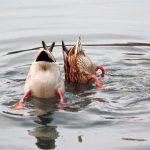Ponds are teeming with life, hosting a diverse array of plants and animals that contribute to the delicate ecosystem. These bodies of water provide a habitat for a wide variety of creatures, each playing a unique role in the pond’s balance and health. Let’s delve into the fascinating world of pond animals and discover the diverse species that call these aquatic environments home.

Credit: www.pinterest.com
1. Fish
Fish are perhaps the most iconic pond animals, and they come in various shapes, sizes, and colors. Common fish species found in ponds include goldfish, koi, catfish, and sunfish. These aquatic creatures play a crucial role in maintaining the pond’s ecosystem by feeding on insects, algae, and other organic matter.
2. Frogs and Toads
Frogs and toads are amphibians that are commonly found in and around ponds. These creatures lay their eggs in the water, and their tadpoles develop into adult frogs or toads. Frogs and toads are essential for controlling insect populations in the pond ecosystem.
3. Turtles
Turtles are another common sight in ponds, basking in the sun on rocks or logs at the water’s edge. Painted turtles, snapping turtles, and red-eared sliders are some of the turtle species that inhabit ponds. These reptiles play a vital role in maintaining the ecological balance of the pond.
Credit: www.enchantedlearning.com
4. Dragonflies and Damselflies
Dragonflies and damselflies are beautiful insects that are often seen darting around ponds. These creatures have unique life cycles that begin in the water as nymphs before emerging as winged adults. Dragonflies and damselflies are important predators, feeding on mosquitoes and other insects.
5. Snails
Snails are common inhabitants of ponds, where they graze on algae and detritus. These slow-moving creatures play a vital role in nutrient cycling and help keep the pond clean by consuming organic matter. Snails are an essential part of the pond’s ecosystem.
6. Birds
Birds are frequent visitors to ponds, where they come to drink, bathe, and feed. Waterfowl such as ducks, geese, and herons are commonly seen in and around ponds, foraging for food and nesting. Birds play a crucial role in the pond ecosystem by contributing to nutrient cycling and controlling insect populations.
7. Insects
Ponds are home to a plethora of insects, including beetles, water bugs, and water boatmen. These insects have adapted to the aquatic environment and play various roles in the pond ecosystem. Some insects feed on algae and detritus, while others serve as prey for larger animals.
8. Crayfish
Crayfish, also known as crawdads or freshwater lobsters, are crustaceans that inhabit ponds and streams. These creatures resemble small lobsters and play a vital role in the pond ecosystem by scavenging on decaying plant and animal matter. Crayfish are an essential part of the food chain in ponds.
9. Aquatic Plants
Aquatic plants are not animals, but they are integral to the pond ecosystem. Plants such as water lilies, cattails, and duckweed provide oxygen, food, and shelter for pond animals. These plants also help regulate water quality and provide habitat for fish and other creatures.
10. Salamanders
Salamanders are amphibians that can be found in and around ponds. These creatures have moist skin and lay their eggs in water. Salamanders are important predators, feeding on insects, worms, and small aquatic creatures. They play a crucial role in maintaining the biodiversity of pond ecosystems.
Conclusion
Ponds are vibrant ecosystems teeming with life, from fish and frogs to turtles and dragonflies. Each species plays a unique role in maintaining the delicate balance of the pond environment. By understanding the diversity of animals that inhabit ponds, we can appreciate the importance of preserving these valuable ecosystems for future generations to enjoy.




